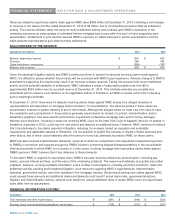GE 2014 Annual Report Download - page 168
Download and view the complete annual report
Please find page 168 of the 2014 GE annual report below. You can navigate through the pages in the report by either clicking on the pages listed below, or by using the keyword search tool below to find specific information within the annual report.
148 GE 2014 FORM 10-K
FINANCIAL STATEMENTS PRESENTATION & POLICIES
On January 1, 2014, we adopted ASU 2013-05, Foreign Currency Matters (Topic 830): 3DUHQW¶V Accounting for the Cumulative
Translation Adjustment upon Derecognition of Certain Subsidiaries or Groups of Assets within a Foreign Entity or of an
Investment in a Foreign Entity. Under the revised guidance, the entire amount of the cumulative translation adjustment
associated with the foreign entity will be released into earnings in the following circumstances: (a) the sale of a subsidiary or
group of net assets within a foreign entity that represents a complete or substantially complete liquidation of that entity, (b) the
loss of a controlling financial interest in an investment in a foreign entity, or (c) when the accounting for an investment in a
foreign entity changes from the equity method to full consolidation. The revised guidance applies prospectively to transactions
or events occurring on or after January 1, 2014.
On January 1, 2014, we adopted ASU 2013-11, Presentation of an Unrecognized Tax Benefit When a Net Operating Loss
Carryforward, a Similar Tax Loss, or a Tax Credit Carryforward Exists. Under the new guidance, an unrecognized tax benefit is
required to be presented as a reduction to a deferred tax asset if the disallowance of the tax position would reduce the
available tax loss or tax credit carryforward instead of resulting in a cash tax liability. The ASU applies prospectively to all
unrecognized tax benefits that exist as of the adoption date and reduced both deferred tax assets and income tax liabilities by
$1,224 million as of January 1, 2014.
On January 1, 2012, we adopted ASU 2011-05, an amendment to Accounting Standards Codification (ASC) 220,
Comprehensive Income. ASU 2011-05 introduced a new statement, the Consolidated Statement of Comprehensive Income.
The amendments affect only the display of those components of equity categorized as other comprehensive income and do
not change existing recognition and measurement requirements that determine net earnings.
On January 1, 2012, we adopted ASU 2011-04, an amendment to ASC 820, Fair Value Measurements. ASU 2011-04 clarifies
or changes the application of existing fair value measurements, including: that the highest and best use valuation premise in a
fair value measurement is relevant only when measuring the fair value of nonfinancial assets; that a reporting entity should
measure the fair value of its own equity instrument from the perspective of a market participant that holds that instrument as
an asset; to permit an entity to measure the fair value of certain financial instruments on a net basis rather than based on its
gross exposure when the reporting entity manages its financial instruments on the basis of such net exposure; that in the
absence of a Level 1 input, a reporting entity should apply premiums and discounts when market participants would do so
when pricing the asset or liability consistent with the unit of account; and that premiums and discounts related to size as a
characteristic of the reporting entity’s holding are not permitted in a fair value measurement. Adopting these amendments had
no effect on the financial statements.
























